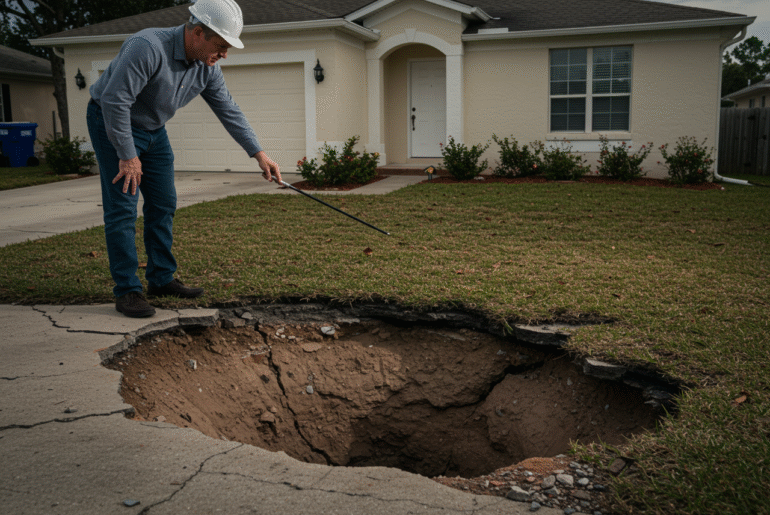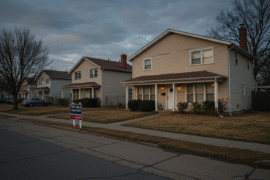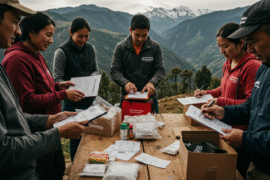This article may contain references to products or services from one or more of our advertisers or partners. We may receive compensation when you click on links to those products or services. Nonetheless, our opinions are our own.
The information presented in this article is accurate to the best of our knowledge at the time of publication. However, information is subject to change, and no guarantees are made about the continued accuracy or completeness of this content after its publication date.
- Sinkholes and Homeowners Insurance
- Causes of Sinkholes
- States With Higher Sinkhole Risk
- What Homeowners Insurance Typically Covers
- Natural Disasters Compared to Covered Events
- Common Exclusions in Insurance Policies
- How to Know If Sinkholes Are Covered
- Difference Between Sinkhole Loss and Ground Collapse
- State-Specific Laws for Sinkhole Insurance
- Ways to Add Sinkhole Protection
- Factors That Affect Premium Pricing
- Final Thoughts
- Frequently Asked Questions
- Recommended Reads
Sinkholes and Homeowners Insurance
Sinkholes can do a lot of damage to homes. But many insurance policies do not cover this natural threat. Even though you may think these events are rare or sudden, they often happen because of slow changes in the ground over time. Most regular home insurance does not include this type of damage. This leaves people open to big money problems if it happens. To better protect your home, you need to know what your policy covers. Also, think about getting more coverage, like endorsements or extra sinkhole insurance. These can help fill any gaps in your current policy and keep your home safe.
Causes of Sinkholes
Sinkholes happen when water wears away underground rock like limestone or gypsum. Other rocks like these can be worn away too. This makes holes under the ground that can one day fall in. This often happens in karst terrain. But nature is not the only reason for them. A lot of building, changing how the water moves, or building too much in one area can make sinkholes form faster.
In places where this kind of land is common, people who own property often get help from experts to look at how risky their land may be. Geological surveys can show weak spots in the land and help people decide if they should get more insurance.
States With Higher Sinkhole Risk
Some states have more sinkholes than others. This is because of the land and weather in the area. Here is a short look at these states:
| Region | Risk Factors |
|---|---|
| Florida | Highest activity; insurers must offer catastrophic ground collapse coverage |
| Tennessee | Mandatory sinkhole coverage in many policies |
| Texas | Susceptible due to variable weather |
| Pennsylvania | Cases linked to human activity, especially development |
| Missouri, Kentucky | History of sinkholes from soluble bedrock |
If you live in one of these states, it is a good idea to get a professional to check your property and your insurance. This will help make sure you have the right coverage.
What Homeowners Insurance Typically Covers
Homeowners insurance usually protects you from things like fire, theft, and wind damage. But most of these plans do not cover earth movement. This means you do not get help for things like landslides, subsidence, and sinkholes. The reason is these things can be hard to predict and can cost a lot. Because of this, insurance companies see them as different risks.
To keep your home safe, you might need to get a special endorsement or a separate sinkhole policy. These extra steps are important if you live in a place that has known risk from the ground shifting.
Natural Disasters Compared to Covered Events
Events like windstorms or theft are usually part of most standard policies. But things like earthquakes, floods, or sinkholes are often not included.
Two types of coverage address sinkholes:
- Sinkhole loss coverage: This may cover damage from things like nature or from some things people do.
- Catastrophic ground cover collapse: This usually pays for big damage that makes the home unsafe or if people can’t live in it.
Each one has its own rules and limits. It is good to talk with your insurance company to find out what fits your area and home.
Voted "Best Overall Budgeting App" by Forbes and WSJ
Monarch Money helps you budget, track spending, set goals, and plan your financial future—all in one app.
Get 50% OFF your first year with code MONARCHVIP
Common Exclusions in Insurance Policies
Homeowners are sometimes surprised by what is not in the plan. Some things that are often left out are:
- Earth movement, like sinkholes, subsidence, or landslides
- Damage from man-made sinkholes, for example, those made by construction
- Damage that was already there, like foundational trouble that was known before the policy started
- Not taking care, such as not fixing or looking into clear structural risks
These gaps can cause repairs that cost a lot if you do not have coverage. Changing your policy to fit what you need helps you avoid that kind of money risk.
How to Know If Sinkholes Are Covered
In most cases, standard homeowners insurance does not cover sinkhole damage. But you can change your policy to get coverage for it.
- Catastrophic ground cover collapse coverage is often something you need in states where there is much risk.
- Sinkhole loss endorsements are also there as add-ons if you want them.
In places like Florida and Tennessee, insurance companies must give some kind of help for sinkholes. Always read your own insurance plan, and talk to your insurance company to see what is included.
Difference Between Sinkhole Loss and Ground Collapse
Even though they may sound the same, these types of coverage are not alike in what they cover.
- Sinkhole loss coverage: This often covers slow or not-too-bad damage. The damage can come from things people do, like mining.
- Catastrophic ground collapse: This happens in very serious cases. It triggers when the building is condemned or is not safe to live in.
Florida puts the latter in all homeowners policies, so there is a base level of safety. But it may not pay for small damage unless you add extra sinkhole coverage.
State-Specific Laws for Sinkhole Insurance
Different states have their own rules when it comes to sinkhole coverage.
- Florida: A policy must include coverage if the ground suddenly falls in and causes big damage. You also have to get an offer for extra sinkhole protection.
- Tennessee: Insurers in the state need to give people choices to get sinkhole insurance.
- Kentucky and Missouri: These states let you add extra sinkhole coverage, but you don’t have to have it.
No matter if you live in a high-risk state or not, it is good to read about your state’s insurance laws. This can help you get the right coverage. Knowing what your state says about insurance will also help you make better choices.
Ways to Add Sinkhole Protection
Many policies do not have sinkhole coverage included at first. To fill this gap, you can:
- Ask for an endorsement that adds sinkhole coverage to your homeowners policy.
- Buy a different sinkhole policy if you live in an area where the ground has a lot of holes or caves.
Talk with a licensed insurance agent to find out your options. The agent can help you know the best way to keep your property safe.
Sinkhole insurance premiums vary based on:
- Geographic location: If the home is in a riskier area, the premium will be higher.
- Home age and condition: Older homes often come with more risk.
- Construction type: Some building materials can stand up to damage better than others.
- Coverage limits and deductibles: If you have higher coverage or lower deductibles, it can make your premium go up.
- Property history: If there has been sinkhole damage in the past, it may make it cost more or be harder to get.
Your insurance company can give you exact prices based on these things.
Steps to Take If You Suspect Sinkhole Damage
If you see strange things happening in your home or yard:
- Look for things like cracks in the walls or foundations, floors that move, or places with dips in the ground.
- Get in touch with someone who works in geology or geotechnical fields. They can help find out if there is any risk.
- Tell your insurance company right away and start writing down everything that happens.
If you move fast, you can stop more damage from happening. This can also make your insurance claim stronger.
Warning Signs of Sinkhole Activity
Be alert to:
- Cracks in drywall, floors, or the foundation
- Low spots or soft areas in the yard
- Sudden holes or empty spaces showing up
- Trees, posts, or fences starting to tilt
- Odd changes in pipes or water lines
These signs may not always mean there is a sinkhole. But they do show that something under the ground could be weak or unsteady.
Filing an Insurance Claim for Sinkhole Damage
Once you’ve confirmed or suspect sinkhole damage:
- Document everything: Take photos, keep notes, and save inspection reports. This helps if you need to show what happened.
- Notify your insurer promptly: Call your insurance company as soon as you can. They might tell you what steps you need to do or which experts you have to use.
- Meet with an adjuster: The adjuster will look at the damage and say if your policy covers it or not.
- Stay involved: Your help and the details you share during the process can make a difference in the result of your claim.
Final Thoughts
Many regular homeowners insurance plans do not cover sinkholes. But you do not have to feel stuck. You can still find options. To keep your home safe, learn about what risks you might have. Look at adding the right coverage. It helps to talk with a skilled insurance agent. This way, your place will be better protected. If you live in a high-risk place or on land that has karst ground, taking these steps can be very important. Doing this will help keep both your house and your money safe.
Frequently Asked Questions
Is sinkhole coverage legally needed anywhere?
Some states, like Florida and Tennessee, have rules that require some sinkhole protection. But most states make it a choice. Look at your state laws or talk to your insurance company to know what is needed in your area.
Will insurance cover minor sinkhole damage?
Most standard policies do not cover this. You will need to get extra sinkhole coverage or a special endorsement for these repairs. Standard coverage often kicks in only when the structure is deemed unsafe to live in.
What if my neighbor’s yard has a sinkhole?
Take pictures and write down what you see. Tell your insurance provider about it. A professional inspection might be needed to check if your own property is at risk. It’s smart to act early to avoid potential structural issues.
Are sinkholes caused by construction or mining covered?
Most of the time, if people create a sinkhole, it is not covered by your insurance. You might need to add extra coverage. A special policy can also help protect you from these kinds of sinkholes. Always ask your insurer about coverage for man-made causes.
Can I get sinkhole insurance after I see signs of damage?
Most of the time, you will not be able to get it. Once you spot any damage, the insurance company may say it is a pre-existing problem. This means it is hard to find a new plan that will cover this kind of issue. Prevention and early coverage are key.

Reviewed and edited by Albert Fang.
See a typo or want to suggest an edit/revision to the content? Use the contact us form to provide feedback.
At FangWallet, we value editorial integrity and open collaboration in curating quality content for readers to enjoy. Much appreciated for the assist.
Did you like our article and find it insightful? We encourage sharing the article link with family and friends to benefit as well - better yet, sharing on social media. Thank you for the support! 🍉
Article Title: Does Homeowners Insurance Cover Sinkholes
https://fangwallet.com/2025/07/20/does-homeowners-insurance-cover-sinkholes/The FangWallet Promise
FangWallet is an editorially independent resource - founded on breaking down challenging financial concepts for anyone to understand since 2014. While we adhere to editorial integrity, note that this post may contain references to products from our partners.
The FangWallet promise is always to have your best interest in mind and be transparent and honest about the financial picture.
Become an Insider

Subscribe to get a free daily budget planner printable to help get your money on track!
Make passive money the right way. No spam.
Editorial Disclaimer: The editorial content on this page is not provided by any of the companies mentioned. The opinions expressed here are the author's alone.
The content of this website is for informational purposes only and does not represent investment advice, or an offer or solicitation to buy or sell any security, investment, or product. Investors are encouraged to do their own due diligence, and, if necessary, consult professional advising before making any investment decisions. Investing involves a high degree of risk, and financial losses may occur including the potential loss of principal.
Source Citation References:
+ Inspo
There are no additional citations or references to note for this article at this time.












































